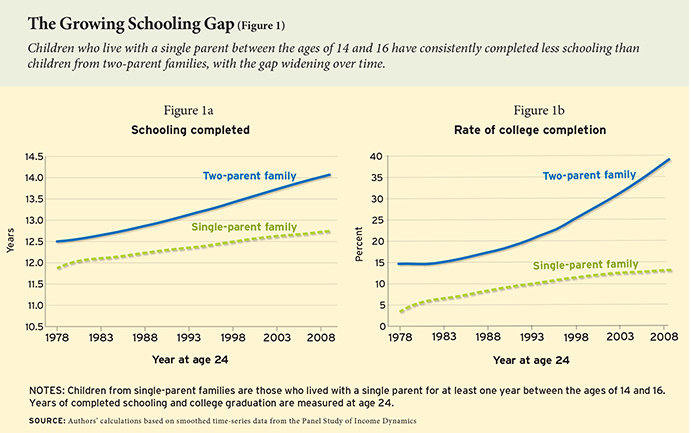You have /5 articles left.
Sign up for a free account or log in.
Spending your teenage years in a single-parent family puts you at a larger educational disadvantage today than it did 40 years ago, claims a new study.
In 2009, young adults who spent time living in single-parent families had completed 1.32 fewer years of schooling than their peers from two-parent families, according to a paper published last week in the academic journal Education Next. The college completion rate also was 26 percentage points lower for 24-year-olds who lived in single-parent homes as teens.
Both gaps have more than doubled since 1978, when there was a 0.63-year difference in schooling completed and a 12 percentage point difference in college completion rates.
Income accounts for a lot of the relationship between family structure and educational attainment, according to the study. But income doesn't account for all of it, and the authors had no answer for why single-parent family structure matters more now than it did a few decades ago.
The paper is part of a series Education Next is publishing on the state of the American family to mark the 50th anniversary of the release of late New York Senator Daniel Patrick Moynihan’s report on black families.
The new study attempts to describe what’s happened with single-parent families and education since the Moynihan Report was published, said Kathleen M. Ziol-Guest, an associate professor at New York University’s Steinhardt School of Culture, Education and Human Development. She cowrote the paper with Greg J. Duncan, an education professor at the University of California at Irvine, and Ariel Kalil, a professor at the Harris School of Public Policy Studies at the University of Chicago.
At the time the Moynihan Report was published, 51 percent of low-income adolescents were living in single-parent families. In the next three decades, the number rose to 75 percent, according to the paper. Over the same period, the percentage of high-income adolescents in single-family homes rose from 3 to 6 percent.
Moynihan’s report focused on black families, but the percentage of children living with a single parent has jumped across racial and ethnic groups. Between 1960 and 2013, the proportion of black children living in a single-parent home more than doubled, from 22 percent to 55 percent, according to data from the U.S. Census Bureau. For white children, the percentage tripled, from 7 percent to 22 percent.
The authors’ analysis of educational attainment is based on data from the Panel Study of Income Dynamics (PSID) from children born between 1954 and 1986. The data includes information about family structure and family income of 6,072 individuals when they were between the ages of 14 and 16, as well as the years of schooling they’d completed by the age of 24.
Those who were 24 years old in 2009 -- the youngest group in the data -- and lived in a two-parent family had completed 14.07 years of school. Those who lived for at least 1 of 3 years between ages 14 and 16 in a single-parent home had finished 12.75 years of school.
Twelve percent of that group of teens from single-parent families had earned a college degree by the time they were 24, compared with 38 percent of those from two-parent families.
Money Matters
The authors found that family income accounts for about half of the educational disadvantage faced by students from single-parent families.
Still, the negative relationship between living with a single parent and educational attainment has grown with each generation since Moynihan’s report was published, Ziol-Guest said.
Living with a single parent all 3 years between ages 14 and 16 was associated with completing 0.92 fewer years of school for children who turned 14 years old between 1989 and 1999. For those who reached 14 between 1968 and 1978, the schooling completion difference was 0.31 fewer years.
Likewise, the probability of graduating from college was reduced 8.1 percentage points for those in the 1968 to 1978 span and 16.6 percentage points for the most recent span.
In other words, the school completion difference nearly tripled, while the reduced likelihood of completing college doubled.
The authors are in the process of breaking down the gaps in education attainment and income inequality to determine how much is attributable to certain demographic characteristics, Ziol-Guest said.
In addition to family structure, the paper also explored the relative amount of schooling children had completed based on factors such as mother's age at child's birth, mother's years of education and number of siblings.
The study confirms research that has shown the most important factor in predicting students’ educational attainment is how far in school their parents progressed. Increasing a mother’s years of education by 1 standard deviation, or 2.6 years, added about three-quarters of a year to children’s completed schooling, according to the study.
Reiterating the importance of a mother’s education in predicting educational attainment is valuable. That’s because while there are limits to what the government can do to influence marriage decisions, there are opportunities to encourage more educational opportunities for mothers, said Richard Kahlenberg, a senior fellow at the Century Foundation. One example he offers is providing child care at community colleges.
Kahlenberg, who’s written about socioeconomic barriers to education, also points out that the study shows that single parenting is now linked more to class than race. In 2013, the gap between the proportion of children living with a single parent was 69 percentage points for rich and poor families. The difference between black and white single-parent families was 33 percentage points.





